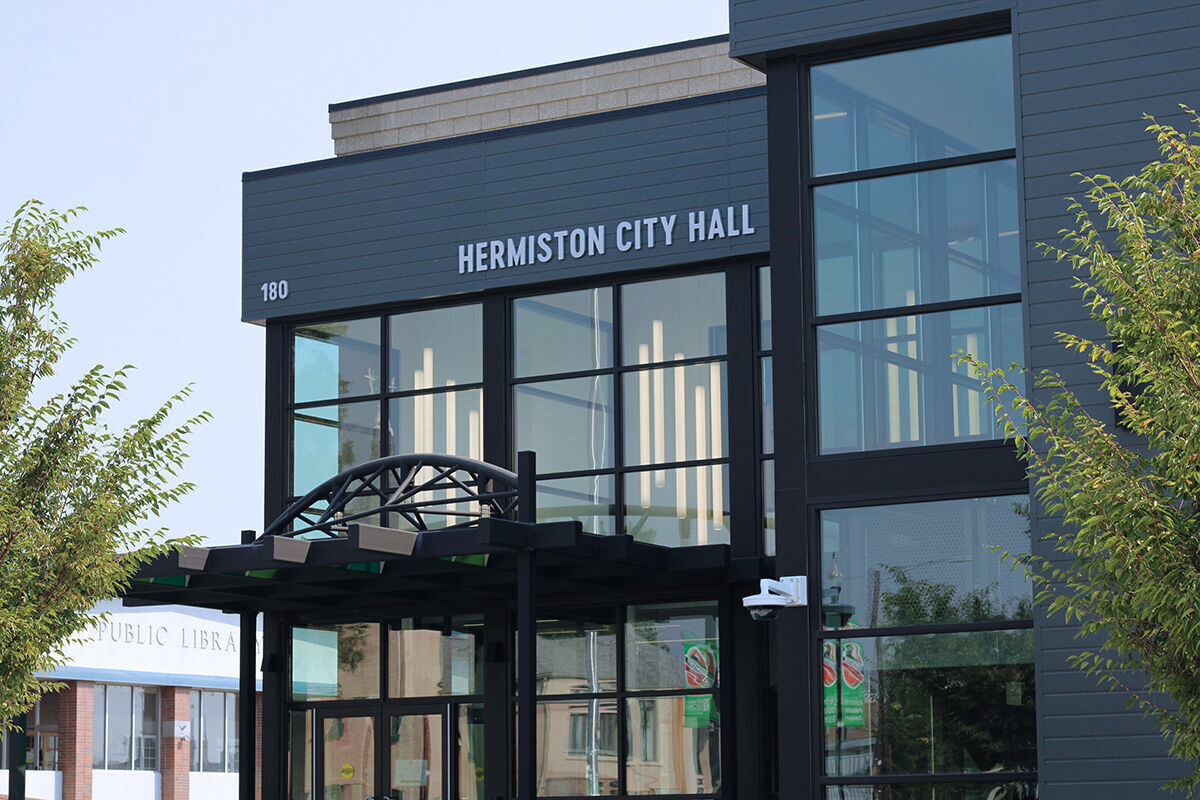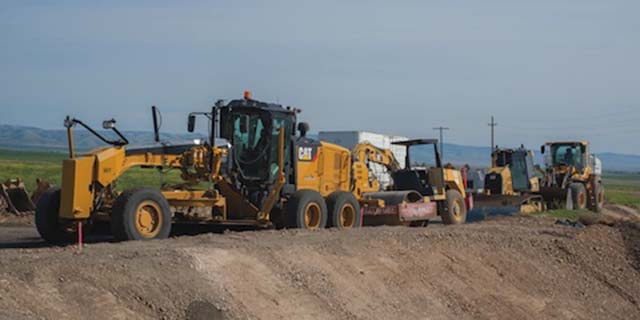Experts offer advice on beating the heat next week
Published 5:00 am Saturday, June 26, 2021

- Cattle find shade under trees on the edge of a field on Friday, June 25, 2021, along Stanfield Meadows Road outside of Stanfield.
Residents across Eastern Oregon can expect some of the highest June temperatures in decades starting Sunday, June 27.
The National Weather Service forecasts temperatures to peak June 28, and June 29, with highs of 107 degrees in Boardman, 111 in Pendleton and 114 in Hermiston. The hottest temperature ever recorded in Hermiston previously was 113 degrees, in 1961.
The conditions could prove unprecedented for the month of June. Rob Brooks, a meteorologist with the National Weather Service in Pendleton, said June temperatures in Umatilla County typically range in the upper 80s.
The federal agency predicts temperatures in excess of 100 to stretch well into next week. Brandon Lawhorn, a forecaster with the National Weather Service in Pendleton, said temperatures could range to as high as 103 degrees through next Friday. Forecasters, he said, are predicting a possible triple-digit Fourth of July throughout the Columbia River Basin.
Take precautions with heat
Steve Hardin, the emergency department manager at St. Anthony Hospital in Pendleton, advised people to stay out of the heat and remain vigilant on the signs of heat exhaustion and heat stroke.
“Limit activity, especially strenuous activity during the hot times,” he said. “If you want to do yard work, get up at 6 in the morning, go outside and do yard work when it’s cooler.”
Hardin advised people to limit their consumption of alcohol, and stay aware of their hydration and water intake when temperatures are high.
“Typically people will consume a large amount of beer and they’ll think they’re staying hydrated, he said. “In all reality they’re dehydrating themselves.”
Hardin said the most common issue for people to be on the lookout for is heat exhaustion, which has symptoms such as headache, lightheadedness, profuse sweating and cold, clammy skin. People also can experience nausea or vomiting and increased thirst.
“You need to hydrate yourself,” he said. “Drink water and sports drinks intermittently.”
If someone begins to show signs of heat exhaustion, Hardin recommended moving them to a cooler place, offering water and sports beverages, such as Gatorade, and using cold compresses or a cold shower to help cool down.
“Don’t put it off, once you start getting symptomatic you need to get out of the heat,” he said. “If you don’t, it will progress to heat stroke.”
Heat stroke is a much more serious condition and requires immediate medical care, Hardin said. Heat stroke presents with delirium, confusion or loss of consciousness as well as nausea and vomiting. People experiencing heat stroke cease sweating and their skin will typically be hot and red. Hardin advised anyone suffering heat stroke to seek emergency medical attention.
“Heat stroke is a true medical emergency, and you need to come to the ER for it,” he said. “Do not give them fluids, they’re confused or altered, they’re in or out of consciousness, you don’t want them to choke.”
The Oregon Occupational Safety and Health Administration on Thursday, June 24, warned that heat illness poses a serious threat to workers who are not prepared for hot weather.
“Employers need to take the threat of heat illness seriously, which means acting sooner — not later — to put the appropriate safeguards in place,” said Penny Wolf-McCormick, statewide health enforcement manager for Oregon OSHA. “And they don’t have to go it alone. Oregon OSHA is ready to help with free expert advice and a variety of educational resources.”
Oregon OSHA recommends employers create a heat illness prevention plan that can include training employees to recognize the signs of heat illness, performing work during the coolest part of the day and providing water, rest and shade, particularly for those in labor-intensive jobs.
Keeping cool inside
If anyone thinks their air conditioning unit isn’t working property or is on the verge of failing, they should call immediately, said Seth Draper, service manager for Bruce Heating and Air, which has locations in Hermiston and the Tri-Cities. HVAC technicians are stretched thin right now, and aren’t available to show up at a moment’s notice.
“We’re slammed,” he said.
As the heat wave across the western United States continues to spread, it’s also taking longer to get parts in — three to five weeks, in the case of the old R22 units that have been phased out.
Draper said to help their air conditioner stay in good working order, it’s important people make sure their filters are clean and so are their outside units, which can become clogged with cottonwood fluff or other debris.
He said as temperatures soar above 110 degrees next week, people will need to have reasonable expectations for how cool they can get the inside of their home.
“One hundred and fifteen degrees outside really stresses AC units,” he said.
People can help reduce that stress by keeping their blinds closed and lights off as much as possible, he said, and not running appliances, such as ovens, that will add heat to the house. They also should reduce traffic in and out of the house as much as possible, and try opening the windows if it cools down at night.
As people crank up the air conditioning, Steve Meyers, spokesperson for Umatilla Electric Cooperative, said the utility will be closely watching weather conditions and system loads. While extreme weather does put additional demand on the power supply, he said UEC has made it a priority to maintain its infrastructure to reliably provide power in all kinds of conditions.
“Our power supply is sufficient to meet the expected spike in demand from air conditioning and irrigation during this extreme heat wave,” he wrote in an email.
He said in a typical year, UEC provides more than $1 million in rebates and $300,000 in low-interest loans for energy efficiency upgrades in members’ homes and businesses. Those investments help reduce the demand on UEC’s system, he said.
Tom Guantt, spokesperson for Pacific Power, said Pacific Power is not expecting any disruptions to the power supply during the heat wave either.
“The system is in good shape, and we have contingency plans for any unforeseen challenges that may arise,” he said. “At the same time, we urge customers to be mindful about their power use both to save power and money.”
In a news release, Pacific Power suggested customers should set their thermostats at 78 degrees while they’re home and 85 degrees while they’re out.
If someone doesn’t have an air conditioner, they can use fans blowing across cool water, bowls of ice or frozen water bottles to help cool down a room, or hang a wet sheet over their window if there is a breeze coming through in the evenings.
Protecting animals
Darren Cox, owner of Baker’s Pond Farm outside Hermiston, said livestock tend to weather the Eastern Oregon climate well, but do need a little extra protection when the heat reaches the extremes expected for next week.
He said he sprays the chickens and ducks with water when it gets especially hot, and when it’s up over 100 degrees sometimes the goats need wetted down too.
“They hate water,” he said of the goats, “but we do spray them when they get hot. You don’t have to do as much with cows. They’re used to the elements.”
The farm’s barn has a big awning where animals can congregate in the shade, he said, and they will have fans running. Pigs don’t sweat, so Cox said he’ll be making sure they have plenty of water and mud to roll around in.
One of the most important things will be making sure animals have “plenty of cool, clean water” in their troughs as they go drink more than usual, Cox said.
“You can go down and buy blocks of ice, and put them in the trough,” he said. “When it’s really hot, on the 115 (degree) day, that’s probably what we’ll do here.”
He’ll be keeping his dog in the air-conditioned house, he said, and if any of the other animals are showing signs of heat exhaustion, they can come inside too.
“When temperatures rise, we do all too often see cases of heat stroke in pets here in Pendleton,” said Dr. Barbara Panata of the Pendleton Veterinary Clinic. “Signs most often include excessive panting and drooling, difficulty breathing, reluctance to move and collapse.”
To prevent these scary and sometimes tragic scenarios, she said there are a few actions owners can take.
Make sure all pets have ready access to water, shade and ventilation. Ideally, she said, owners should leave pets in a home with air conditioning. And they should be under supervision when outdoors in the hot summer.
“Not only is drinking water essential, but it can also be very helpful to provide water to get them wet,” Panata said. “Dogs don’t sweat all over their bodies to dissipate heat the way we do (they sweat through their paws), so getting pets wet can be helpful. Some dogs enjoy kiddy pools.”
Walk or run with pets in the early, cool part of the day, and before the asphalt gets hot, and make sure they get breaks with access to water.
Owners should take extra care with breeds with shorter muzzles, such as pugs and bull dogs, she said. They are at a higher risk for overheating because they are not as effective at dissipating heat as other breeds. Likewise, pet owners should take precautions with animals that are older, overweight or have medical conditions, such as a respiratory or cardiac disease. These “higher risk patients,” she said, would do best with air conditioning and not being out into the heat.
“If you have concerns that your pet might be showing signs of heat stroke, provide them with cool water, wet their fur, and act quickly to get them to a veterinary clinic,” Panata said.
And do not leave pets in vehicles unattended, she stressed. No cracked window will compensate for the oven created within a vehicle in hot temperatures.
Oregon’s good Samaritan law, which has been in effect for four years, allows someone to enter a vehicle to remove a child or domestic animal in imminent danger of suffering harm without facing criminal or civil liability under certain requirements. That law could get a workout with this heat.
Hermiston Police Chief Jason Edmiston said police are supposed to base their actions on what is reasonable in the circumstances, and that’s a measuring stick that can apply to the good Samaritan law.
“Is it reasonable to leave an animal in a vehicle with no ventilation?” he said. “The answer is no, it’s not reasonable.”
He said police would like to be involved if someone has to break into a car to save a child or pet, but the department’s resources are limited. If a child or pet is in imminent danger, he said, don’t wait for the police.
“There is no real justification for people or animals to be left inside vehicles in the weather that’s on the horizon for us,” Edmiston said.
Local resources
Pendleton Police Chief Chuck Byram said the high temperatures raise concerns for people’s well-being.
“With the heat coming, what we worry about the most are the elderly and people who don’t have the means to cool themselves down,” he said.
Byram encouraged people to check on their family and friends more often during the next week. Protracted heat tends to fray the nerves, he said, and police see more nighttime activity than daytime activity.
People seeking shelter from the heat in Umatilla County can do so at several places.
The Hermiston Public Library on 235 E. Gladys Ave. will be open at limited capacity June 26 from 10 a.m. to 5 p.m. It will be closed on June 27 but will reopen on June 27, again from 10 a.m. to 8 p.m., according to Mark Rose, the library director.
The Pendleton Warming Station on 715 S.E. Court Ave. will expand its hours and act as a cooling station during the the weekend. It will open from 1-6 p.m. each day through June 27. The station is seeking volunteers to remain open for those needing shelter next week. The station will have water bottles, Gatorade and some snacks, according to Dwight Johnson, executive director at Neighbor 2 Neighbor Pendleton, the nonprofit that operates the station.
And the Fellowship Hall at the Wesley United Methodist Church on 816 S. Main St. in Milton-Freewater will be open as a cooling station from June 26-29, 12-6 p.m., according to its Facebook page.
In Morrow County, from Saturday to Monday people can cool off from noon to 6 p.m. at Riverside High School in Boardman, Oregon Trail Library in Irrigon and Heppner Elementary School in Heppner.
The National Weather Service is predicting peak temperatures Monday, June 28, of 112 in Pendleton and 114 in Hermiston.
The last time Pendleton reported hotter temperatures was 1961, with 113 degrees. Temperatures have never reached that high in Hermiston, according to the National Weather Service.
But all of those temperatures fall below the hottest temperature ever reported in Pendleton. On Aug. 10, 1898, the city reported 119 degrees Fahrenheit, according to the National Weather Service and the East Oregonian physical archives. That also is the hottest temperature recorded in Oregon, tied with Prineville’s temperatures that same year.
The region had been “treated to a spell of weather the like of which has never been known heretofore,” the East Oregonian reported the day after the record-high temperatures. Back then, however, the thermometers only went up to 115 degrees, so the additional four degrees had to be “measured by the observer,” the newspaper reported.
The heat became central to several stories the newspaper reported that day.
A fire extended more than a mile and a half and destroyed more than 11,000 bushels of wheat and barley on a farm just east of Pendleton. The likely cause was matches someone dropped that were “ignited by the warm rays of the sun,” the newspaper reported.
A 14-year-old boy named Louis Fletcher had been working his father’s harvest field that day when the heat knocked him unconscious and left him in “a very serious condition” for several hours before he eventually recovered.
The local “woolen mills and wool scouring mills” closed and sent workers home due to temperatures that topped 122 in the facility’s shade.
Meanwhile, the “ladies of the Christian church” planned an ice cream social on the courthouse lawn the following day to support the “Ladies Aid Society.”





